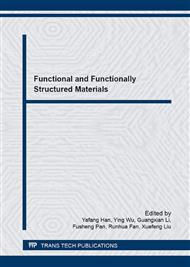[1]
Sarikaya A, Petrovsky V, Dogan F, Development of the anode pore structure and its effects on the performance of solid oxide fuel cells. J International Journal of Hydrogen Energy. 38(2013) 10081-10091.
DOI: 10.1016/j.ijhydene.2013.05.160
Google Scholar
[2]
Horri B A, Selomulya C, Wang H, Characteristics of Ni/YSZ ceramic anode prepared using carbon microspheres as a pore former. J International Journal of Hydrogen Energy. 37(2012) 15311-15319.
DOI: 10.1016/j.ijhydene.2012.07.108
Google Scholar
[3]
Duan N Q, Yan D, Chi B, et al, High performance anode-supported tubular solid oxide fuel cells fabricated by a novel slurry-casting method. J Scientific reports. 2015, 5.
DOI: 10.1038/srep08174
Google Scholar
[4]
Cowin P I, Petit C T G, Lan R, et al, Recent progress in the development of anode materials for solid oxide fuel cells. J Advanced Energy Materials. 1(2011) 314-332.
DOI: 10.1002/aenm.201100108
Google Scholar
[5]
Wachsman E D, Marlowe C A, Lee K T, Role of solid oxide fuel cells in a balanced energy strategy. J Energy & Environmental Science. 5(2012) 5498-5509.
DOI: 10.1039/c1ee02445k
Google Scholar
[6]
Horri B A, Selomulya C, Wang H, Electrochemical characteristics and performance of anode-supported SOFCs fabricated using carbon microspheres as a pore-former. J International Journal of Hydrogen Energy. 37(2012) 19045-19054.
DOI: 10.1016/j.ijhydene.2012.10.005
Google Scholar
[7]
Xiao G, Wang S, Lin Y, et al, Releasing metal catalysts via phase transition: (NiO) 0. 05-(SrTi0. 8Nb0. 2O3) 0. 95 as a redox stable anode material for solid oxide fuel cells. J ACS applied materials & interfaces. 6(2014) 19990-19996.
DOI: 10.1021/am5055417
Google Scholar
[8]
Kim Y H, Kim H G, The effect of Bi2O3 on the microstructure and electrical conductivity of ZrO2-Y2O3 ceramics. J Journal of Materials Science: Materials in Electronics. 5(1994) 260-266.
DOI: 10.1007/bf00921248
Google Scholar
[9]
Ran S, Winnubst A J A, Koster H, et al, Sintering behaviour and microstructure of 3Y-TZP+ 8mol% CuO nano-powder composite. J Journal of the European Ceramic Society. 27(2007) 683-687.
DOI: 10.1016/j.jeurceramsoc.2006.04.039
Google Scholar
[10]
Gulino A, La Delfa S, Fragala I, et al, Low-temperature stabilization of tetragonal zirconia by bismuth. J Chemistry of materials. 8(1996) 1287-1291.
DOI: 10.1021/cm950558j
Google Scholar
[11]
MORI M, LIU Y, MA S, HASHIMOTO S-i, YASUMOTO K, Effects of Bi Addition on Sintering and Electrical Properties of Scandia Stabilized Zirconia as Intermediate-Temperature SOFC Electrolyte. J Electrochemistry. 77(2009) 184-189.
DOI: 10.5796/electrochemistry.77.184
Google Scholar
[12]
Solovyev A A, Sochugov N S, Rabotkin S V, et al, Application of PVD methods to solid oxide fuel cells. J Applied Surface Science. 310(2014) 272-277. 5℃/min 升温.
DOI: 10.1016/j.apsusc.2014.03.163
Google Scholar


